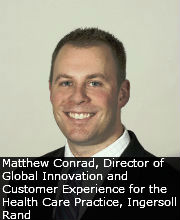Access control, particularly biometrics, is a key focus in health care facilities. As part of the mainstream push to user-friendly solutions that are easy to understand and use, open systems and plug-and-play devices are opening up their lead in popularity contests. Video analytics continue to simmer on the sidelines, while cloud-based systems and technologies, despite the hype, have yet to come into their own. a&s takes a look at the major technologies shaping the health care world.
Major smart-card issuance efforts, such as a recent US government initiative, are resolving issues, including lack of reader infrastructure. Commercially, smart cards finally benefit from reader infrastructure that goes beyond physical access to encompass logical access. Part and parcel of this effort are mobile phones, used for both access and payments.

Putting his money on smart cards is
Matthew Conrad, Director of Global Innovation and Customer Experience for the Health Care Practice, Ingersoll Rand. “The number of credentialed applications in health care facilities is increasing rapidly.” Once just used to gain entrance to parking garages or secured areas, credentials (cards or keyfobs) now grant access to computer networks and other electronic information — payments in the cafeteria, vending machines, time and attendance, authorized access to pharmaceuticals or patient records.
Eric Assouline, Export Sales Manager at CDVI, also points to access control

innovation in RFID and biometric technologies. “Manufacturers have not yet taken full advantage of these technologies,” Assouline said, as trust issues remain. “While biometric and RFID technologies have improved over the past 10 to 15 years, improvements still need to be made.” For example, 256-bit encryption is helping foster end-user confidence.
 More than a pretty face
More than a pretty faceNext-generation biometric technologies could be worth US$14 billion globally by 2017, at a CAGR of nearly 20 percent. With major improvements in sensors and applications, sales globally are already $6 billion annually, with the U.S. accounting for $2 billion to $3 billion alone. Biometrics deployments in the health care sector have traditionally been “extremely difficult and problematic,” said Phil Scarfo, VP of Worldwide Sales and Marketing at Lumidigm. “Most conventional biometric systems fail to operate reliably in harsh environments. Frequent hand washing, heavy use of chemicals and cleaners, wearing of latex gloves and demographic issues make accurate biometrics enrollment and authentication challenging.”
Multispectral imaging, according to Scarfo, uses multiple wavelengths of light and advanced polarization techniques that extract unique fingerprint characteristics from both skin surfaces and subsurfaces, effectively addressing environmental issues. “The fingerprint ridges on finger surfaces have their foundation beneath the skin's surface in capillary beds and other subdermal structures.” The visible fingerprint, he added, is merely “an echo of foundational inner fingerprints.” Unlike surface fingerprint characteristics that can be obscured by moisture, dirt or wear, inner fingerprints lie undisturbed and deliver more consistent, tamper-resistant results.

For
John Davies, MD at Time and Data Systems International (TDSi), other innovative players include China-based Hanvon and ZK Software. Another notable business, in his view, is Germany-based Cognitec, which excels in high-end facial recognition algorithms used in video analytics. According to IMS Research, the market for video analytics will reach $600 million by 2015. Following increased use of motion detection and camera-tampering applications, it anticipates increased market differentiation and heightened demand for more sophisticated applications. However, despite the drop in processing costs, Davies does not see the technology as being ready for mass acceptance. “Biometrics via video analytics is still not quite there.” Coupled this with the fact that the health care sector is slightly behind other government-funded and managed critical infrastructure, he sees more widespread adoption taking place several years away.
User-friendly integration
Scarfo sees system complexity as creating new needs. “Hospitals are busy places with hundreds, sometimes thousands, of people logging onto multiple systems several times a day from different locations. While authentication solutions must comply with extensive regulations, they must also be convenient, secure and reliable. Providing convenient, secure and reliable authentication solutions to hospital systems is a challenge.”
Security directors often manage multiple security systems that operate independently and do not communicate. According to Conrad, this leads to duplicated efforts, increased risk and difficulty making informed decisions. “Health care providers want solutions that connect disparate systems, drive enhanced communication, enable task automation and workflows, and provide important information and data when and where needed.” The key is to integrate not only physical security systems but also building management and business systems. “Doing so improves productivity, intelligence and visibility to operations.”
Developing global solutions to integrate access control with video surveillance and other electronic security equipment and systems is a must, Assouline said. “That is why we are moving to develop high-end, performance-based algorithms that enable real integration. While integration has long been a buzzword, it is only now that intelligent products and systems can truly ‘talk to each other.'”
One major area in this arena is ready-to-use, plug-and-play systems. Panels, according to Assouline, can be prewired and preassembled, and the power supply can be included in the controller. “There is no need for complicated configuration. There is no complicated installation. Installers find that they can do more jobs without extensive training.”
According to Davies, the natural instinct for companies is to try to lock their customers into proprietary systems. “You can smile at your customers, but if they find that their feet are nailed to the ground when they get up to leave, you are not really developing customer loyalty.” Digitalization and harmonization are not the only potential issues; project complexity is another source of frustration and cost overruns. “Often, not enough time is spent planning. What happens is that, two or three years down the road, someone thinks of a new need that no one considered before. Accommodating these new requirements is what really adds to the cost.”
Still in the clouds?
While many talk about cloud computing, enterprises have been slow to take it up due to perceived security concerns. Companies are making increasing efforts to hone mobile strategies to enable employees to use mobile devices. This is putting pressure on IT departments to develop appropriate security infrastructure.
“Cloud” is now just about as much of a buzzword as “integration,” Assouline said, while fully admitting that the technology offers many advantages. “We have seen many companies moving toward this technology, and everyone seems to like it. Cloud-based systems offer many more services and, most importantly, redundancy; if one system goes down, the rest are 100-percent safe.”
Over the next five to 10 years, cloud-based systems will become increasingly accepted and relevant, Davies said. These systems have not yet reached their full potential, given the “reticence of end users.”
“Many data security personnel are not ready to give up control.” Davies finds this attitude somewhat contradicting to daily activity; many shop online regularly, providing credit card and bank information without any hesitations. The big issue with video surveillance is the sheer volume of data and requirements of decent playback speeds. That said, in 10 years, Davies believes that cloud-based systems will represent a 35- to 40-percent share of the market.